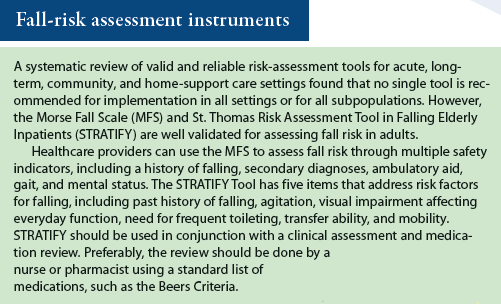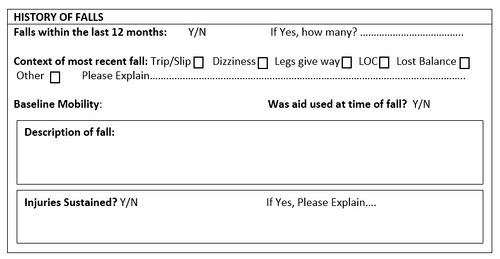The Basic Principles Of Dementia Fall Risk
The 30-Second Trick For Dementia Fall Risk
Table of ContentsThe smart Trick of Dementia Fall Risk That Nobody is DiscussingDementia Fall Risk Things To Know Before You BuyUnknown Facts About Dementia Fall RiskThe Only Guide to Dementia Fall Risk
A fall danger assessment checks to see exactly how likely it is that you will fall. It is mainly provided for older grownups. The evaluation normally consists of: This includes a collection of questions regarding your total wellness and if you've had previous falls or troubles with equilibrium, standing, and/or walking. These tools test your stamina, balance, and stride (the way you walk).STEADI consists of screening, analyzing, and intervention. Interventions are suggestions that may lower your threat of falling. STEADI includes 3 actions: you for your threat of falling for your threat variables that can be improved to try to avoid drops (as an example, equilibrium issues, impaired vision) to decrease your threat of falling by making use of effective approaches (for instance, supplying education and sources), you may be asked a number of concerns including: Have you dropped in the previous year? Do you really feel unstable when standing or walking? Are you stressed concerning falling?, your service provider will check your strength, balance, and stride, utilizing the adhering to autumn evaluation devices: This test checks your gait.
You'll sit down once more. Your provider will certainly examine the length of time it takes you to do this. If it takes you 12 seconds or more, it may indicate you are at higher danger for a fall. This test checks toughness and balance. You'll sit in a chair with your arms went across over your upper body.
The placements will certainly obtain harder as you go. Stand with your feet side-by-side. Move one foot midway onward, so the instep is touching the big toe of your various other foot. Move one foot completely before the other, so the toes are touching the heel of your other foot.
An Unbiased View of Dementia Fall Risk
Most falls take place as a result of multiple adding aspects; consequently, taking care of the risk of falling begins with determining the variables that add to drop threat - Dementia Fall Risk. A few of the most appropriate danger aspects include: Background of previous fallsChronic clinical conditionsAcute illnessImpaired stride and balance, reduced extremity weaknessCognitive impairmentChanges in visionCertain high-risk medications and polypharmacyEnvironmental aspects can additionally enhance the danger for drops, consisting of: Insufficient lightingUneven or damaged flooringWet or slippery floorsMissing or damaged handrails and get hold of barsDamaged or incorrectly fitted equipment, such as beds, mobility devices, or walkersImproper use of assistive devicesInadequate supervision of the people residing in the NF, including those who display hostile behaviorsA effective fall threat monitoring program requires a thorough great site medical evaluation, with input from all members of the interdisciplinary group

The treatment strategy should additionally consist of treatments that are system-based, such as those that advertise a secure environment (proper lights, handrails, get bars, etc). The effectiveness of the interventions must be reviewed occasionally, and the treatment plan modified as required to show adjustments in the loss risk assessment. Carrying out a loss risk monitoring system making use of evidence-based finest practice can decrease the prevalence of drops in the NF, while limiting the possibility for fall-related injuries.
Dementia Fall Risk for Dummies
The AGS/BGS standard suggests evaluating all grownups matured 65 years and older for loss danger every year. This testing contains asking patients whether they have actually dropped 2 or more times in the previous year or sought medical attention for an autumn, or, if they have actually not dropped, whether they really feel unstable when strolling.
People who have dropped as soon as without injury should have their balance and stride reviewed; those with stride or balance irregularities need to get additional evaluation. A history of 1 loss without injury and without gait or equilibrium problems does not require additional evaluation past continued yearly autumn threat screening. Dementia Fall Risk. A find out loss risk evaluation is required as component of the Welcome to Medicare exam

4 Simple Techniques For Dementia Fall Risk
Recording a drops history is just one of the high quality signs for autumn prevention and monitoring. A crucial component of threat assessment is a medication evaluation. Numerous courses of medicines enhance loss threat (Table 2). copyright drugs particularly are independent predictors of drops. These medicines often tend to be sedating, modify the sensorium, and hinder balance and stride.
Postural hypotension can typically be minimized by reducing the dosage of blood pressurelowering medicines and/or stopping medicines that have orthostatic hypotension as a negative effects. Use of above-the-knee support tube and copulating the head of the bed raised might likewise decrease postural reductions in blood stress. The recommended components of a fall-focused checkup are displayed in Box 1.

A Yank time better than or equivalent to 12 seconds suggests high autumn danger. Being incapable to stand up from a chair of knee elevation without utilizing one's arms indicates enhanced fall risk.